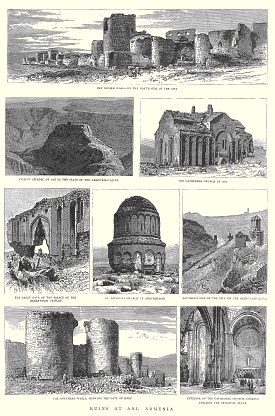 |
 |  |

AN ILLUSTRATED WEEKLY NEWSPAPER - SATURDAY, SEPTEMBER 26, 1885
THE RUINS OF ANI
These magnificent ruins are situated about thirty miles S.E. of the famous fortress of Kars. Ani was the capital of Greater Armenia, when that nationality attained its greatest extent and. development under the dynasty of King Ashod I. (A.D. 859 - 1045), who claimed descent from King David of Judah. At the end of this period, through the intrigues of the Greek Emperors, Armenia was absorbed in the Byzantine Empire, but soon fell from its feeble grasp, and was successively occupied by Georgians, Tartars, and Ottoman Turks. The inhabitants suffered such miseries that some of them at last resolved to seek safety in emigration, and successively colonised the Crimea, Poland, Wallachia, and Hungary, carrying with them their commercial enterprise, agricultural skill, and civilised arts. These colonies are still extant. Many of the inhabitants of Ani, under one Rupen, fled to the mountains of Cilicia, where for three centuries they maintained their |  |
freedom. The close of the fourteenth century saw also the termination of Armenian supremacy and independence. As early as the sixth century Ani is mentioned as a strong natural fortress, but it was afterwards, by King Ashod and his successors, transformed into the capital city of Armenia.
With reference to our views of the Cathedral, James Ferguson, the architectural writer, says: "Ani was adorned by the Bagradite dynasty with a series of buildings which still strike the traveller with admiration, at least for the beauty of their details, for, like all churches in this part of the world, they are very small. Indeed, all the buildings in the Armenian provinces are so small that they would hardly deserve a place in a history of architecture were it not for the ingenuity of their plans and the elegance of their details. The antiquity also of the Cathedral enhances its interest, since it was founded so long ago as 980 A.D. One peculiarity will be noticed in this style of building, namely, the angular recess which marks the form of the apses outside without breaking the main lines of the building."
Another illustration shows the southern side of the city, with a view of the citadel. The western end of the northern walls shows the Gate of Kars, which was the principal entrance to the city. These walls are remarkable for the round and square towers which surmount them at intervals, and for the stones of various colours employed in their construction. St. Saviour's Church was built by Aboulgharib, the Armenian Governor of Ani, in 1035. It has twelve sides - four without, and eight semicircular large niches within. The ruins of the large gate of the palace of the great Bahlavouni princes are highly interesting on account of their beautiful Oriental engravings and mosaics. The entire city is very tastefully built of black, red, and green lava. These variegated materials enter largely into the construction of the churches, palaces, baths, and other buildings.
After the conclusion of the Russo-Turkish War of 1877-78, when Ani passed into the hands of Russia, the late Armenian Catholicos, Gregorius IV., desired to restore the churches and other public buildings, and to repopulate the city with Armenians. The work was begun, but the Russian Government objected, and therefore the design had to be deferred to a more favourable opportunity. Our engravings are from photographs by Ohannes Kurkdjian, of Erivan and Tiflis, and have been forwarded to us by Mr. G. Hagopian.

|
|